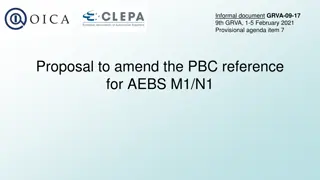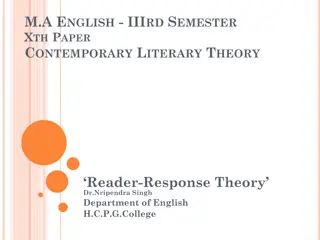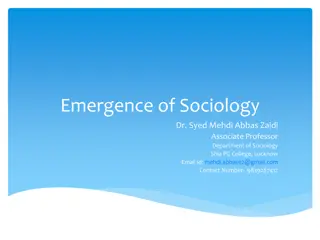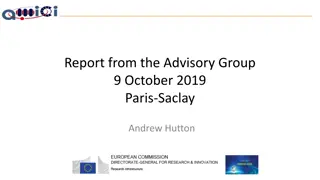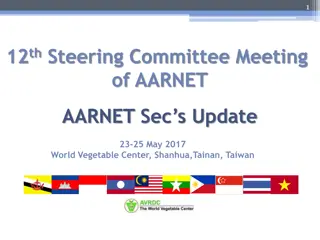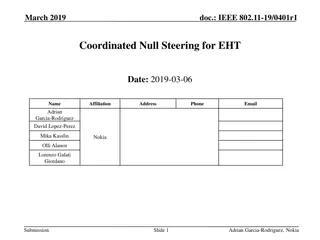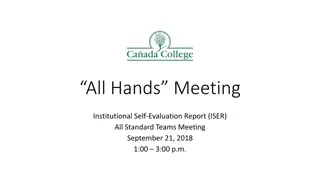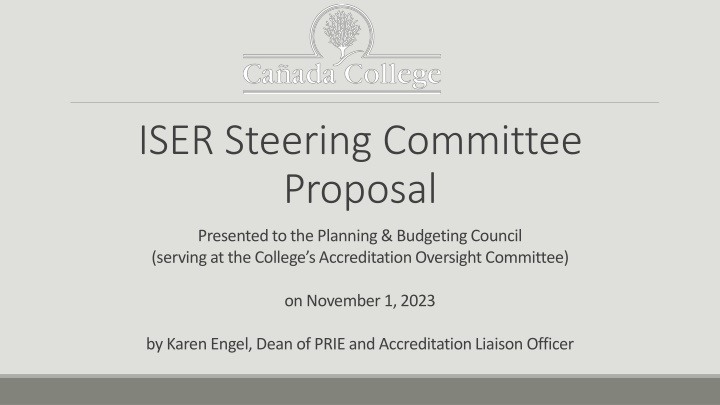
Establishing an Accreditation Steering Committee for ISER Preparation
Take a strategic approach to ISER preparation by establishing an Accreditation Steering Committee to oversee the process effectively. Duties include reviewing evidence, identifying key contributors, advising on addressing gaps, and facilitating campus participation. The committee's composition involves tri-chairs for different standards and representation from faculty, staff, administration, and college leadership. Learn about the proposed initial approach for identifying administrative, council, senate, and committee leads for each standard, starting with Institutional Mission and Effectiveness. Prepare for Spring 2024 with enhanced oversight and guidance for the ISER proposal.
Download Presentation

Please find below an Image/Link to download the presentation.
The content on the website is provided AS IS for your information and personal use only. It may not be sold, licensed, or shared on other websites without obtaining consent from the author. If you encounter any issues during the download, it is possible that the publisher has removed the file from their server.
You are allowed to download the files provided on this website for personal or commercial use, subject to the condition that they are used lawfully. All files are the property of their respective owners.
The content on the website is provided AS IS for your information and personal use only. It may not be sold, licensed, or shared on other websites without obtaining consent from the author.
E N D
Presentation Transcript
ISER Steering Committee Proposal Presented to the Planning & Budgeting Council (serving at the College s Accreditation Oversight Committee) on November 1, 2023 by Karen Engel, Dean of PRIE and Accreditation Liaison Officer
Overseeing the Colleges Institutional Self Evaluation Report (ISER) Preparation The PBC serves as the College s Accreditation Oversight Committee Starting in Spring 2024, more oversight and guidance will be needed to prepare our ISER Proposal: establish an Accreditation Steering Committee
Duties of the Steering Committee Look at the required evidence for each Standard Help identify individuals and groups on campus best positioned to help find evidence for each Standard Advise the Accreditation Liaison Officer and Faculty Accreditation Lead in determining how to best address gaps in evidence that are found Review drafts of the Institutional Self Evaluation Report and facilitate campus participation as needed
Composition of the Steering Committee Tri-Chairs for Standard 1 Tri-Chairs for Standard 2 Tri-Chairs: one each from: Tri-Chairs for Standard 3 Faculty Classified Staff Administration Tri-Chairs for Standard 4 Accreditation Liaison Officer Accreditation Faculty Lead Administrators as needed College President
Proposed Initial Approach for Identifying Administrative, Senate, Council, and Committee Leads for Each Standard Ca ada Lead Administrator Ca ada Lead Council, Senate, or Committee Standard 1: Institutional Mission and Effectiveness The institution has a clearly defined mission that reflects its character, values, organizational structure, and unique student population. The mission outlines the institution s explicit commitment to equitable student achievement and serves as a guiding principle for institutional planning, action, evaluation, improvement, and innovation. 1.1. The institution has established a clearly defined mission that appropriately reflects its character, values, structure, and unique student demographics. The institution s mission articulates its commitment to ensuring equitable educational opportunities and outcomes for all students. 1.2. The institution establishes meaningful and ambitious goals for institutional improvement, innovation, and equitable student outcomes. 1.3. The institution holds itself accountable for achieving its mission and goals and regularly reviews relevant, meaningfully disaggregated data to evaluate its progress and inform plans for continued improvement and innovation. 1.4. The institution s mission directs resource allocation, innovation, and continuous quality improvement through ongoing systematic planning and evaluation of programs and services. PRIE Dean PBC PRIE Dean PBC PRIE Dean PBC PRIE Dean PBC PRIE Dean, Director of Marketing 1.5. The institution regularly communicates progress toward achieving its mission and goals with internal and external stakeholders in order to promote understanding of institutional strengths, priorities, and areas for continued improvement. ??
Proposed Initial Approach for Identifying Administrative, Senate, Council, and Committee Leads for Each Standard Ca ada Lead Administrator Ca ada Lead Council, Senate, or Committee Standard 2: Student Success In alignment with its mission, the institution delivers high-quality academic and learning support programs that engage and support students through their unique educational journeys. Academic and learning support programs promote equitable student success, and the institution evaluates student learning and achievement data to inform improvements and advance equitable outcomes. 2.1. Academic programs at all locations and in all modes of delivery are offered in fields of study consistent with the institution s mission and reflect appropriate breadth, depth, and expected learning outcomes. 2.2. The institution, relying on faculty and other appropriate stakeholders, designs and delivers academic programs that reflect relevant discipline and industry standards and support equitable attainment of learning outcomes and achievement of educational goals. 2.3. All degree programs include a general education framework to ensure the development of broad knowledge, skills, and competencies related to communication, quantitative reasoning, critical thinking, information literacy, civic responsibility, and the ability to engage with diverse perspectives. 2.4. The institution communicates clear, accurate, and accessible information regarding programs, services, and resources that foster success in students unique educational journeys. 2.5. The institution holds itself accountable for students success by scheduling courses in a manner that ensures degree and certificate programs can be completed in the expected period of time. 2.6. The institution uses delivery modes and teaching methodologies that meet student and curricular needs and promote equitable student learning and achievement. 2.7. The institution designs and delivers equitable and effective services and programs that support students in their unique educational journeys, address academic and non-academic needs, and maximize their potential for success. Such services include library and learning resources, academic counseling and support, and other services the institution identifies as appropriate for its mission and student needs. VPI IPC, Academic Senate VPI IPC, Academic Senate VPI IPC, Academic Senate VPI, VPSS, Marketing IPC, SSPC VPI IPC, Academic Senate VPI IPC, Academic Senate VPSS SSPC Dean of ASLT ASLT Division and IPC, Academic Senate 2.8. The institution fosters a sense of belonging and community with its students by providing multiple opportunities for engagement with the institution programs and peers. Such opportunities reflect the varied needs of the student population and effectively support students unique educational journeys. 2.9. The institution conducts systematic review and assessment to ensure the quality of its academic learning support and student services programs and implement improvements and innovations in support of equitable student achievement. VPSS SSPC PRIE Dean PBC
Proposed Initial Approach for Identifying Administrative, Senate, Council, and Committee Leads for Each Standard Ca ada Lead Administrator Ca ada Lead Council, Senate, or Committee Standard 3: Infrastructure and Resources The institution supports its educational services and operational functions with effective infrastructure, qualified personnel, and stable finances. The institution organizes its staffing and allocates its physical, technological, and financial resources to improve its overall effectiveness and promote equitable student success. The institution actively monitors and assesses resource capacity to inform improvements to infrastructure and ensure long-term health and stability. 3.1. The institution employs qualified faculty, staff, administrators, and other personnel to support and sustain educational services and improve student success. The institution maintains appropriate policies and regularly assesses its employment practices to promote and improve equity, diversity, and mission fulfillment. 3.2. The institution supports its employees with professional learning opportunities aligned with the mission and institutional goals. These opportunities are regularly evaluated for overall effectiveness in promoting equitable student success and in meeting institutional and employee needs. 3.3. The institution evaluates its employees regularly, using clear criteria that align with professional responsibilities and reflect the institution s mission and goals. 3.4. The institution develops, maintains, and enhances its educational services and operational functions through the effective use of fiscal resources. Financial resources support and sustain the mission and promote equitable achievement of student success. 3.5. The institution s mission and goals are the foundation for financial planning. Financial information is disseminated to support effective planning and decision-making and provide opportunities for stakeholders to participate in the development of plans and budgets. 3.6. The institution ensures the integrity and responsible use of its financial resources and regularly evaluates its fiscal outcomes and financial management practices to promote institutional mission fulfillment. 3.7. The institution ensures financial solvency. When making short-range financial plans, the institution considers its long-range financial priorities and future obligations to ensure sustained fiscal stability. 3.8. The institution constructs and maintains physical resources to support and sustain educational services and operational functions. The institution ensures safe and effective physical resources at all locations where it offers instruction, student services, and/or learning supports. 3.9. The institution implements, enhances, and secures its technology resources to support and sustain educational services and operational functions. The institution clearly communicates requirements for the safe and appropriate use of technology to students and employees and employs effective protocols for network and data security. 3.10. The institution has appropriate strategies for risk management and has policies and procedures in place to implement contingency plans in the event of financial, environmental, or technological emergencies and other unforeseen circumstances. College President SMCCCD Human Resources College President SMCCCD Human Resources College President SMCCCD Human Resources VPAS SMCCCD Administrative Services VPAS SMCCCD Administrative Services VPAS SMCCCD Administrative Services VPAS SMCCCD Administrative Services VPAS SMCCCD Administrative Services VPAS SMCCCD ITS VPAS SMCCCD Administrative Services
Proposed Initial Approach for Identifying Administrative, Senate, Council, and Committee Leads for Each Standard Ca ada Lead Administrator Ca ada Lead Council, Senate, or Committee Standard 4: Governance and Decision-Making The institution engages in clear and effective governance practices that support the achievement of its mission. Governance roles and responsibilities are delineated in widely distributed policies, and institutional decision-making processes provide opportunities for meaningful participation and inclusion of relevant stakeholders. 4.1. The institution upholds an explicit commitment to principles of academic freedom, academic integrity, and freedom of inquiry. 4.2. Roles, responsibilities, and authority for decision-making are clearly defined and communicated throughout the institution. The institution s structure for decision-making provides opportunities for stakeholder participation and ensures the inclusion of relevant perspectives. 4.3. The institution s decision-making structures are used consistently and effectively. Institutional decision-making practices support a climate of collaboration and innovation that advances the mission and prioritizes equitable student outcomes. 4.4. Acting through policy, the governing board takes responsibility for the overall quality and stability of the institution, and regularly monitors progress towards its goals and fiscal health. 4.5. The governing board selects and evaluates the institution s chief executive officer (CEO). The governing board gives the CEO full authority to implement board policies and ensure effective operations and fulfillment of the institutional mission. 4.6. The governing board functions effectively as a collective entity to promote the institution s values and mission and fulfill its fiduciary responsibilities. The governing board demonstrates an ability to self-govern in adherence to its bylaws and expectations for best practices in board governance. VPI Academic Senate Dean of PRIE PBC Dean of PRIE PBC College President BOT/Chancellor College President BOT/Chancellor College President BOT/Chancellor
Initial Timeline for ISER Preparation: 2023-2025 PBC (Accreditation Oversight Committee) reviews new Standards and adopts overall timeline for the Self Evaluation process Administrative Leads for each Standard review new Standards and expectations for the Self-Evaluation Process with College Councils and Senates Fall 2023 PBC forms an ISER Steering Committee that includes faculty, classified staff, and student leaders to join Administrative leads for each Section of the ISER to begin work in Spring/Fall 2024 Accreditation Steering Committee develops detailed plan for Report preparation. Administrative and Senate Leads begin identifying and collecting evidence. Administrative and Senate Leads identify any areas that need to be addressed (where evidence may be lacking) and presents these to PBC. Spring 2024 PBC recommends how to address gaps in practice or evidence and Administrative and Senate leads work with Councils, Senates, and Committees to address them Administrative, Senate, Council and Committee Leads address gaps in evidence, begin collecting and organizing evidence, and drafting brief narratives. Fall 2024 First Draft of ISER completed and all evidence gathered and organized. Spring 2025 Second and final Draft of ISER completed and submitted to BOT for approval. Fall 2025 Final ISER Submitted to ACCJC by December, 2025.
Information and Resources Ca ada Accreditation Website ACCJC Resources Website Accreditation Manual (new as of 2023)





